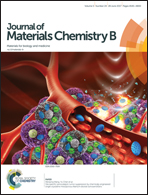Importance of zwitterionic incorporation into polymethacrylate-based hydrogels for simultaneously improving optical transparency, oxygen permeability, and antifouling properties†
Abstract
Conventional 2-hydroxyethyl methacrylate (HEMA)-based hydrogels have an inverse relationship between optical transparency (OP) and oxygen permeability (Dk) as a function of water content. While the higher water content favors the oxygen permeability of HEMA-based hydrogels, it also causes poor optical transparency due to the water-induced scattering center effect. Here, we propose and demonstrate that the incorporation of zwitterionic [2-(methacryloyloxy)ethyl]dimethyl-(3-sulfopropyl) ammonium hydroxide (SBMA) with HEMA hydrogels enables the achievement of both properties (OP = 98% and Dk = 54.7) in hydrogels at high water contents of 84%, and both values are much higher than those of pure HEMA hydrogels (OP = 2.3% and Dk = 17.5 barriers). HEMA–SBMA hydrogels are crosslinked by electrostatic interactions between the zwitterionic SBMA groups and hydrogen bonds between the HEMA groups. The introduction of SBMA into HEMA not only increases the quantity and quality of strongly binding water inside the networks, but also affects the porous structure of the gels, both of which are correlated with OP and Dk. Moreover, hybrid HEMA–SBMA hydrogels demonstrate their excellent antifouling function to prevent nonspecific protein adsorption in vitro, as well as their biocompatibility and hemocompatibility when implanted in mice in vivo. A combination of these excellent properties of HEMA–SBMA hydrogels (high water content, high optical transparency, high oxygen permeability, good antifouling function, and low foreign-body reaction) makes them highly promising for contact lens-based ophthalmic applications. This work, in line with our other HEMA–CBMA hydrogels, offers a new strategy to design hybrid hydrophilic-zwitterionic materials for improving their multi-faceted properties of interest, beyond the conventional designs of hydrophilic–hydrophilic and hydrophilic–hydrophobic materials.



 Please wait while we load your content...
Please wait while we load your content...